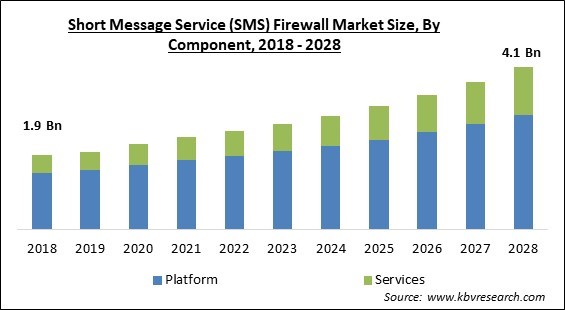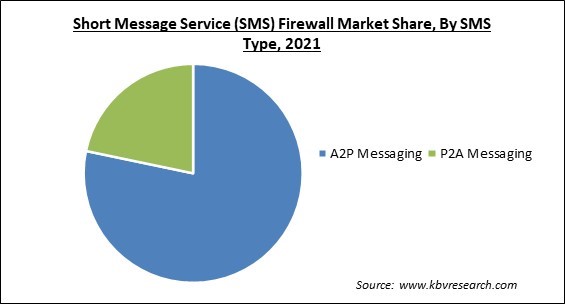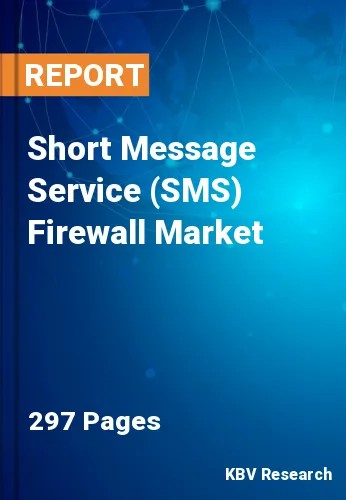The Global Short Message Service (SMS) Firewall Market size is expected to reach $4.1 billion by 2028, rising at a market growth of 8.7% CAGR during the forecast period.
By defending mobile networks from all SMS-based messaging attacks, offering complete security and protection over all messaging networks, accurately identifying & blocking spam, and making sure that all received message traffic is monitored to prevent SMS fraud, an SMS firewall allays security concerns.

Businesses have benefited from the rapid development of technology as well as message marketing, which has allowed them to expand their market reach and thrive in their niches. This advancement in technology has also opened up a lot of opportunities for fraud and false messaging, which has been a significant security concern. To resolve all of these problems that may put a barrier between a company and its clients, an SMS firewall comes to the rescue.
A short Message Service (SMS) Firewall was developed to protect mobile networks against SMS's vulnerable security flaws. It gives complete protection and control over all Messages on the network and safeguards mobile networks against all SMS-based messaging assaults. Every Message is forwarded through the firewall, where it is evaluated and categorized. This implies that screening extends to outgoing roamers as well. Short Message Peer-to-Peer communication is classified according to content, and SMPP (Short Message Peer-to-Peer) traffic takes action to block threats and grey routes.
Many organizations have been able to feel secure due to the SMS firewall, which also opened up fresh avenues for generating income. The expanding timeline of events has been upsetting for both the brand and its customers, causing a gulf between the two and eroding trust. It can be automatically identified and stopped by an SMS firewall. The sender of an A2P (application-to-person messaging) SMS that has been blocked due to fraud or suspicion would be informed that their Message has been sent, even though it has actually been deleted from the network. Alternatively, a warning to the recipient might be included in grey or suspicious A2P SMS messages.
Huge numbers of people have died as a result of the COVID-19 pandemic outbreak. The spread of the virus has had a significant negative impact on the economy as well. Tourism, manufacturing, and financial sectors around the world have all taken significant hits. On the other hand, amid the outbreak, online marketplaces have seen a considerable upsurge. Governments all across the world established strict lockdowns and social seclusion standards. Working from home became a popular trend at that time throughout all the countries. The prevalence of fraud and hacking activities increases with the expansion of online work. Short messaging service (SMS) firewall market growth has benefited from this throughout the pandemic time, owing to all these factors.
The market is growing as a result of the increasing popularity of application-to-person communications. As a result, mobile Network Operators have seen an increase in application-to-Person (A2P) messaging, or one-directional messaging from an application to a person where no response is anticipated (MNOs). A2P and message services, for instance, saw tremendous commercial development in 2020 as a result of the COVID-19 epidemic, and several mobile carriers also experienced exponential growth. Therefore, these factors propel the growth of the short message service firewall market during the projection period.
The major advantage is that it assists in the eradication of "grey routes." An SMS firewall can assist in blocking a grey route, a channel of SMS transmission that is not secure. Additionally, it aids in charging each SMS that terminates in the network correctly. It is helpful in ensuring the network's transparency and aids in maximizing revenue from such an underutilized source of income. In addition, rising grey route traffic is generating illegal traffic, such as malware and scams. The SMS firewall market is anticipated to grow as regulations that require periodic checks and the identification and blocking of grey channels are implemented.
The network cannot be completely protected by the firewall from every zero-day malware. A poor network setup and design will render a firewall worthless. There is a chance that a firewall won't be able to stop threats from popular ports or applications. Tunneled traffic might not be understood by a firewall. For banned ports, the firewall responds with "Deny" rather than "drop." This gives the attacker more information or speeds up the port scan for the attacker. If a firewall isn't regularly updated and maintained, it could become incompatible with emerging technology. They are, therefore, unable to protect themselves from complex threats.
Based on component, the short message service (SMS) firewall market is categorized into platform and services. In 2021, the platform segment held the highest revenue share in the short message service (SMS) firewall market. This is attributable to the increase in end-user usage of SMS firewall platforms for enhancing platform security, particularly in the BFSI and IT & telecom sectors. The development and modernization of A2P SMS have led to a rise in the demand for such messaging services among corporate companies, which is driving the growth of SMS Firewall platforms.

On the basis of SMS type, the short message service (SMS) firewall market is divided into A2P messaging and P2A messaging. The P2A messaging segment garnered a significant revenue share in the short message service (SMS) firewall market. The demand for automated messaging systems is predicted to increase across a number of industries, including banking, healthcare, government, and education. The use of SMS firewalls to protect the current network structures against technological intrusions is driving up demand for them. P2A messaging reduces reliance on people and speeds up and improves the efficiency of technical work by allowing users to test the software with a specific code or set of words to accomplish a function.
Based on deployment mode, short message service (SMS) firewall market is segmented into on-premise and cloud. In 2021, the on-premise segment registered the maximum revenue share in the short message service (SMS) firewall market. The on-premise SMS firewall gives MNOs more control over policing nefarious SMS traffic. The revenue of the telecom provider is harmed by the spam text messages as well as the consumer. To fight such spam SMS traffic, telecom carriers utilize SMS firewall solutions. This SMS firewall system includes reporting tools, content-based filtering, and rules-based filtering.
On the basis of SMS traffic, short message service (SMS) firewall market is classified into national and international. The international SMS traffic segment recorded a remarkable revenue share in the short message service (SMS) firewall market in 2021. The transportation of SMS messages from one nation to another is referred to as international SMS traffic. Businesses are eager to connect with their clients on a worldwide scale using straightforward and accessible communication methods. Sending SMS messages outside of a nation is referred to as international SMS traffic.
Based on end user, the short message service (SMS) firewall market is fragmented in BFSI, IT & telecom, retail & e-commerce, healthcare, media & entertainment, government & public sector, and others. In 2021, the IT & telecom segment held the highest revenue share in the short message service (SMS) firewall market. SMS firewalls prevent spam by preventing unwanted traffic, which can be detrimental to the safety of network users and the revenue of telecom carriers. They are available in two SMS kinds, A2P and P2A, enabling them to be utilized by a wide range of end customers in a variety of industries. This is projected to increase the use of SMS firewalls in the telecom sector and, as a result, boost the segment’s revenue.
| Report Attribute | Details |
|---|---|
| Market size value in 2021 | USD 2.3 Billion |
| Market size forecast in 2028 | USD 4.1 Billion |
| Base Year | 2021 |
| Historical Period | 2018 to 2020 |
| Forecast Period | 2022 to 2028 |
| Revenue Growth Rate | CAGR of 8.7% from 2022 to 2028 |
| Number of Pages | 297 |
| Number of Tables | 530 |
| Report coverage | Market Trends, Revenue Estimation and Forecast, Segmentation Analysis, Regional and Country Breakdown, Companies Strategic Developments, Company Profiling |
| Segments covered | Component, SMS Type, Deployment Mode, SMS Traffic, End User, Region |
| Country scope | US, Canada, Mexico, Germany, UK, France, Russia, Spain, Italy, China, Japan, India, South Korea, Singapore, Malaysia, Brazil, Argentina, UAE, Saudi Arabia, South Africa, Nigeria |
| Growth Drivers |
|
| Restraints |
|
On the basis of region, the short message service (SMS) firewall market is analyzed across North America, Europe, Asia Pacific, and LAMEA. In 2021, the North America region led the short message service (SMS) firewall market with maximum revenue share. This is because the region has a highly digitalized technical sector, which necessitates a higher level of network monitoring and is driving up demand for SMS firewalls. Businesses in industries like government, e-commerce, travel, finance, and banking have an increasing requirement for application-to-person messaging, which has increased the market for SMS firewalls and supported market expansion in this sector.
Free Valuable Insights: Global Short Message Service (SMS) Firewall Market size to reach USD 4.1 Billion by 2028
The market research report covers the analysis of key stake holders of the market. Key companies profiled in the report include Comviva Technologies Limited (Tech Mahindra Limited), Infobip Ltd., Adaptive Mobile Security Limited (Enea AB), Tata Communications Limited (Tata Group), Proximus Group (BICS), Sinch AB, Mobilem Inc., Cellusys Limited, Monty Mobile, and Proofpoint, Inc.
By Component
By SMS Type
By Deployment Mode
By SMS Traffic
By End User
By Geography
The global Short Message Service (SMS) Firewall Market size is expected to reach $4.1 billion by 2028.
Increased acceptance of application-to-person messaging are driving the market in coming years, however, Vulnerabilities in existing firewall systems restraints the growth of the market.
Comviva Technologies Limited (Tech Mahindra Limited), Infobip Ltd., Adaptive Mobile Security Limited (Enea AB), Tata Communications Limited (Tata Group), Proximus Group (BICS), Sinch AB, Mobilem Inc., Cellusys Limited, Monty Mobile, and Proofpoint, Inc.
The expected CAGR of the Short Message Service (SMS) Firewall Market is 8.7% from 2022 to 2028.
The A2P Messaging segment acquired maximum revenue share in the Global Short Message Service (SMS) Firewall Market by SMS Type in 2021 thereby, achieving a market value of $3.1 billion by 2028.
The North America market dominated the Global Short Message Service (SMS) Firewall Market by Region in 2021, and would continue to be a dominant market till 2028; thereby, achieving a market value of $1.5 billion by 2028.
Our team of dedicated experts can provide you with attractive expansion opportunities for your business.

